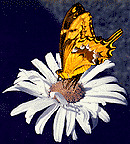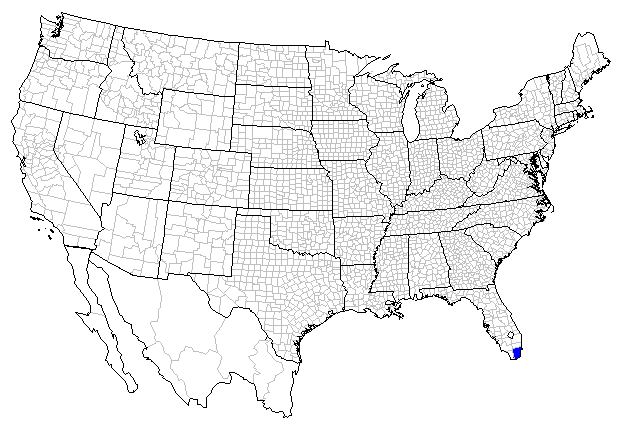

Identification: Upperside of forewing has narrow central yellow
band. Tails edged with yellow, filled with black.
Life history: The Males patrol in tree canopy for receptive females.
The females lay single eggs on top of young host plant leaves.
Caterpillars feed on young leaves and shoots. They hibernate as
chrysalids, which can remain dormant for up to 2 years. Adult
emergence is prompted by rainfall.
Flight: Primary flight from lateApril to mid-June; some adults fly
in late
July and early September.
Caterpillar hosts: They love to eat plants in the citrus family
(Rutaceae) including Citrus species, hop tree (Ptelea trifoliata),
Zanthoxylum spp., and torchwood (Amyris elemifera).
Adult food: Nectar from flowers of cheese-shrub, wild coffee, and
guava.
Habitat: Found only in tropical hardwood
hammocks and
neighboring scrub areas. The adults prefer shady habitat for feeding
and oviposition while the larvae are more commonly found on host
plants which grow in open areas. The primary larvae host plant,
torchwood, is most abundant in disturbed areas which have been
partially deforested by storm or fire, or which have been cleared for
trails or powerline rights-of-way. However, the relative abundance
of torchwood is also high within mature hammocks.
Range: North Key Largo and the larger Keys in Biscayne National
Monument (subspecies ponceanus), south to the Greater Antilles
(other subspecies).
Conservation: Listed in 1984 as Endangered by the U.S. Fish and
Wildlife Service under the Endangered Species Act.
STATUS: Endangered, Federal Register, August 31, 1984
Description: Adults have black-brown wings with yellow
markings, and a broad rusty patch underneath the hind wing at the
outer end of the discal cell and a short distance around the sides of
the cell. The single pair of tails is straight and of constant width with
a
dark center and yellow margin. The Schaus swallowtail
is distinguished from the closely-related giant swallowtail (P.
cresphontes) by smaller size and by the upper forewing submarginal
spots being parallel to the margin of the wing.
The newly emerged larvae are black-brown with a white thirteenth
segment and a light speck on each side of the seventh ring. This
speck becomes a white spot at the first molt. The second instar
larvae are lighter in color with blue or metallic dots; white coloring
the anal segment extends into the twelfth segment. The third instar
larvae have irregular light blotches along the sides of the body,
and a seventh ring white spot that extends into the eighth ring. The
fourth instar larvae (2O days) have creamish yellow markings
except on the anal segment hood and the third ring, which have
robin's egg blue spots on a maroon background. The fifth instar has
blackish-brown true legs and white prolegs and anal prolegs. In all,
the instar's coloring resembles a bird dropping. When this
butterfly is disturbed, a white bifurcated organ protrudes from its
nape and exudes a strong odor. Mature larvae are 56 millimeters
long. In addition to the Schaus swallowtail, there are also two other
subspecies of P. aristodemus, one is found in Haiti and the other in
Cuba.
Feeding Habits: Adults feed on the nectar from blossoms of
guava (Psidium guajava), wild tamarind, and cheese shrub.
The larvae feed on the tender new growth of torchwood (Amyris
elemifera) and wildlime (Xanthoxylum fagara). Both of these plants are
pioneering shrubs in whose shade sprout hardwood seedlings which
eventually form the hammock.
Reproduction and Development: Most reproduction is
associated with the start of the rainy season, April to June. This seems
to trigger a synchronous emergence of adults. Eggs aredeposited on
top of new leaves developing at the branch tips of the host
plants. The pale, greenish-colored eggs hatch in about 3 to 5 days. At
the age of 2O days the larvae enter their fourth and last molt. The
larvae are solitary. The mature larva forms an upright or vertical
chrysalis which is gray or rusty brown. The pupal stage remains
for a year or two and is presumably a mechanism to synchronize adult
emergence with the rainy season and the appearance of new growth.
Adults have a life span of about 1 month.
Range and Population Level: The Schaus swallowtail
butterflycan be found in the upper Florida Keys from Elliot Key in
Biscayne National Park to northern Key Largo and on Upper
Matecumbe Key. In the past, it ranged from the south Miami area
down the Florida Keys to Lower Matecumbe Key. Annual
population have not exceeded 1,OOO adults in the last 4 years, and
the only sizeable populations are restricted to Keys within Biscayne
National Park. The 1988 population size was estimated at 7OO to
85O adults.
Reasons for Current Status: Factors considered as
causes for the decline include: habitat destruction by developers,
overcollecting of larvae, the widespread aerial application
of insecticides, and extreme climatic conditions such as hurricanes,
freezes, and droughts. Collection of eggs and larvae is considered
more serious than collection of adults because the adults lay eggs
soon after emerging and are short-lived.
Management and Protection: Actions recommended for
the recovery of the Schaus swallowtail butterfly include the
following: (1) Maintain existing colonies by surveying for colonies and
acquiring land to protect hammocks from development; (2) Determine
such as habitat requirements, factors affecting population dynamics,
and the effects of currently-used insecticides and their application; (3)
Re-establish colonies in appropriate areas within the historic
range; and, (4) Monitor reestablished colonies and habitat.
Recent studies completed by the Department of Entomology at the
University of Florida indicate pesticides play a critical role in the
survival of the Schaus swallowtail butterfly. Surveys conducted before
and after population numbers. Butterfly populations are the
most vigorous in areas where mosquito control pesticides are
prohibited, such as Biscayne National Park. Continued research and
management of these areas is essential to the survival of the Schaus
swallowtail butterfly.


 |
 |